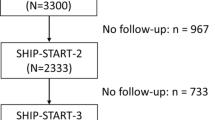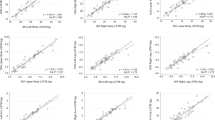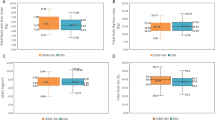Abstract
Objective:
To evaluate the possibility that measurement of the magnitude and distribution of fundamental somatic heat-producing units using dual-energy X-ray absorptiometry (DXA) can be used to estimate resting energy expenditure (REE) in both young and elderly women with different aerobic fitness levels.
Subjects and methods:
Peak oxygen uptake (VO2 peak) and REEm were directly measured in 116 young (age: 22.3±2.1 years) and 72 elderly (63.3±6.4 years) women. The subjects were divided into four groups according to categories of age and VO2 peak; young: high fitness (YH, n=58); low fitness (YL, n=58); elderly: high fitness (EH, n=37) and low fitness (EL, n=35). Using DXA, systemic and regional body compositions were measured, and REEe was estimated from the sum of tissue organ weights multiplied by corresponding metabolic rate.
Results:
Although there were remarkable differences in systemic and regional body compositions, no significant differences were observed between REEm and REEe in the four groups. REEe significantly correlated with REEm in elderly as well as young women; the slopes and intercepts of the two regression lines were statistically not different between the elderly and young groups (elderly: y=0.60x+472, r=0.667; young: y=0.78x+250, r=0.798; P<0.001, respectively). A Bland–Altman analysis did not indicate bias in calculation of REE for all the subjects.
Conclusion:
These results suggest that REE can be estimated from tissue organ components in women regardless of age and aerobic fitness.
This is a preview of subscription content, access via your institution
Access options
Subscribe to this journal
Receive 12 print issues and online access
$259.00 per year
only $21.58 per issue
Buy this article
- Purchase on Springer Link
- Instant access to full article PDF
Prices may be subject to local taxes which are calculated during checkout




Similar content being viewed by others

References
Bland JM, Altman DG (1986). Statistical methods for assessing agreement between two methods of clinical measurement. Lancet 8, 307–310.
Cunningham JJ (1980). A reanalysis of the factors influencing basal metabolic rate in normal adults. Am J Clin Nutr 33, 2372–2374.
Cunningham JJ (1991). Body composition as a determinant of energy expenditure: a synthetic review and a proposed general prediction equation. Am J Clin Nutr 54, 963–969.
Elia M (1992). Organ and tissue contribution to metabolic rate. In: Kinney JM, Tucker HN (eds). Energy Metabolism: Tissue Determinants and Cellular Corollaries. Raven Press: New York, pp 61–80.
Fukagawa NK, Bndini LG, Young JB (1990). Effect of age on body composition and resting metabolic rate. Am J Physiol 259, E233–E238.
Gallagher D, Allen A, Wang Z, Heymsfield SB, Krasnow N (2000). Smaller organ tissue mass in the elderly fails to explain lower resting metabolic rate. Ann NY Acad Sci 904, 449–455.
Gallagher D, Belmonte D, Deurenberg P, Wang Z, Krasnow N, Pi-Sunyer FX et al. (1998). Organ-tissue mass measurement allows modeling of REE and metabolically active tissue mass. Am J Physiol 275, E249–E258.
Grande F (1989). Energy expenditure of organs and tissues. In: JM Kinney (ed). Assessment of Energy Metabolism in Health and Disease. Ross Laboratories: Columbus, OH, pp 88–92.
Guo SS, Zeller C, Chumlea WC, Siervogel RM (1999). Aging body composition, and lifestyle: the FELS longitudinal study. Am J Clin Nutr 70, 405–411.
Hayes M, Chustek M, Wang Z, Gallagher D, Heshka S, Spungen A et al. (2002). DXA: potential for creating a metabolic map of organ-tissue resting energy expenditure components. Obes Res 10, 969–977.
Heymsfield SB, Gallagher D, Kotler DP, Wang Z, Allison DB, Heshka S (2002). Body-size dependence of resting energy expenditure can be attributed to non-energetic homogeneity of fat-free mass. Am J Physiol Endocrinol Metab 282, E132–E138.
Heymsfield SB, Smith R, Aulet M, Bensen B, Lichtman S, Wang J et al. (1990). Appendicular skeletal muscle mass: measurement by dual-photon absorptiometry. Am J Clin Nutr 52, 214–218.
Holliday MA, Potter D, Jarrah A, Bearg S (1967). The relation of metabolic rate to body weight and organ size. Pediatr Res 1, 185–195.
Hunter GR, Weinsier RL, Gower BA, Wetzstein C (2001). Age-related decrease in resting energy expenditure in sedentary white women: effects of regional differences in lean and fat mass. Am J Clin Nutr 73, 333–337.
Johnson MS, Figueroa-Colon R, Herd SL, Fields DA, Sun M, Hunter GR et al. (2000). Aerobic fitness, not energy expenditure, influences subsequent increase in adiposity in black and white children. Pediatrics 106, E50.
Kim J, Wang Z, Heymsfield SB, Baumgartner RN, Gallagher D (2002). Total-body skeletal muscle mass: estimation by a new dual-energy X-ray absorptiometry method. Am J Clin Nutr 76, 378–383.
Nelson KM, Weinsier RL, Long CL, Schutz Y (1992). Prediction of resting energy expenditure from fat-free mass and fat mass. Am J Clin Nutr 56, 848–856.
Piers LS, Soares MJ, McCormack LM, O'Dea K (1998). Is there evidence for an age-related reduction in metabolic rate? J Appl Physiol 85, 2196–2204.
Pollock ML, Foster C, Knapp D, Rod JL, Schmidt DH (1987). Effect of age and training on aerobic capacity and body composition of master athletes. J Appl Physiol 62, 725–731.
Ravussin E, Bogardus C (1989). Relationship of genetics, age, and physical fitness to daily energy expenditure and fuel utilization. Am J Clin Nutr 49, 968–975.
Santa-Clara H, Szymanski L, Ordille T, Fernhall B (2006). Effects of exercise training on resting metabolic rate in postmenopausal African American and Caucasian women. Metabolism 55, 1358–1364.
Snyder WS, Cook MJ, Nasset ES, Karhausen LR, Howells GP, Tipton IH (1975). Report of the Task Group of Reference Man. Pergamon Press: Oxford.
Svendsen OL, Hassager C, Christiansen C (1995). Age- and menopause-associated variations in body composition and fat distribution in healthy women as measured by dual-energy X-ray absorptiometry. Metabolism 44, 369–373.
Tataranni PA, Ravussin E (1995). Variability in metabolic rate: biological sites of regulation. Int J Obes Relat Metab Disord 19, S102–S106.
Van Pelt RE, Dinneno FA, Seals DR, Jones PP (2001). Age-related decline in RMR in physically active men: relation to exercise volume and energy intake. Am J Physiol Endocrinol Metab 281, E633–E639.
Van Pelt RE, Jones PP, Davy KP, Desouza CA, Tanaka H, Davy BM et al. (1997). Regular exercise and the age-related decline in resting metabolic rate in women. J Clin Endocrinol Metab 82, 3208–3212.
Vaughan L, Zurlo F, Ravussin E (1991). Aging and energy expenditure. Am J Clin Nutr 53, 821–825.
Weir JB (1949). New methods for calculating metabolic rate with special reference to protein metabolism. J Physiol 109, 1–9.
Acknowledgements
We express our appreciation to the subjects for their cooperation in this study. We thank the members of the National Institute of Health and Nutrition for their help in this experiment. This study was supported by a Research Grant for Academic Frontier Projects from the Ministry of Education, Culture, Sports, Science and Technology (05F-02), a Waseda University Grant for Special Research Projects (2005A-932, 2006B-242), Health Sciences Research Grants from the Ministry of Health, Labor and Welfare, Medical Health Care Research Grants from the Consolidated Research Institute for Advanced Science and Medical Care at Waseda University and Research Grants from the Japanese Olympic Committee.
Author information
Authors and Affiliations
Corresponding author
Rights and permissions
About this article
Cite this article
Usui, C., Takahashi, E., Gando, Y. et al. Resting energy expenditure can be assessed by dual-energy X-ray absorptiometry in women regardless of age and fitness. Eur J Clin Nutr 63, 529–535 (2009). https://doi.org/10.1038/sj.ejcn.1602980
Received:
Revised:
Accepted:
Published:
Issue Date:
DOI: https://doi.org/10.1038/sj.ejcn.1602980
Keywords
This article is cited by
-
Effect of resistance training on resting metabolic rate and its estimation by a dual-energy X-ray absorptiometry metabolic map
European Journal of Clinical Nutrition (2015)


